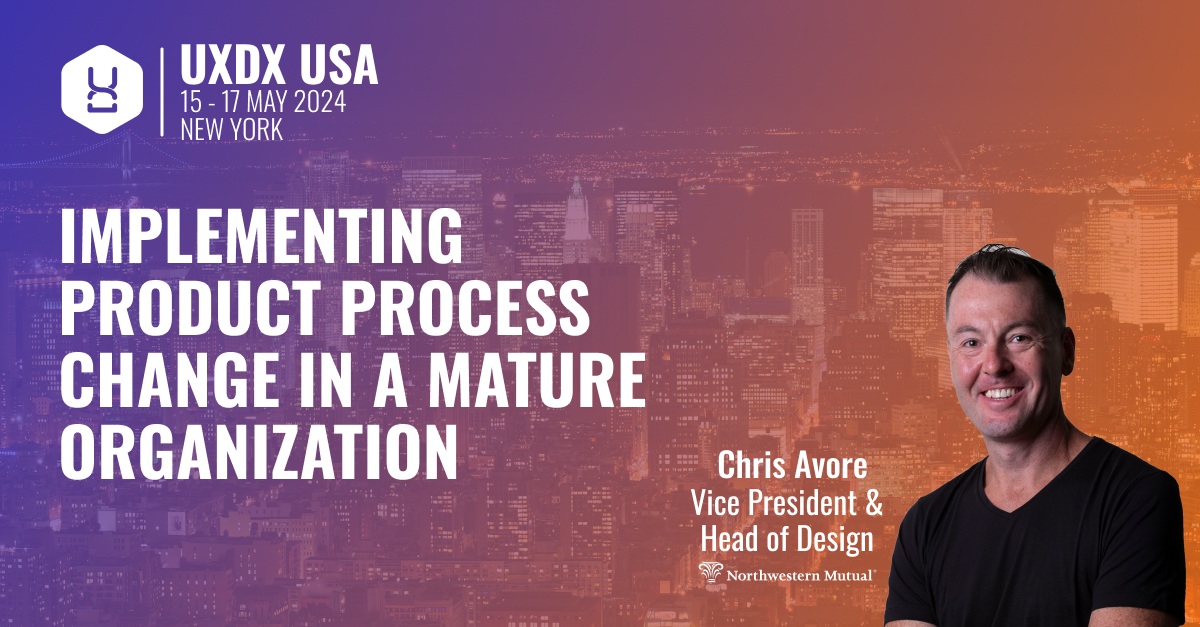The Challenge of Process in Mature Organizations

Processes can be both a blessing and a burden. In mature organizations, they provide structure, continuity, and predictability. But they can also be rigid, bureaucratic, and resistant to change. At UXDX USA 2024, Chris Avore, Head of Design at Northwestern Mutual, tackled this challenge head-on in his talk, Implementing Product Process Change in a Mature Organization.
Avore laid out a compelling case for why process should be seen as an enabler rather than an inhibitor of innovation. He explored how structured, intentional frameworks can help design and product teams operate more effectively, align with business goals, and foster a culture of continuous improvement.
So, how do you introduce change in a way that gains buy-in rather than resistance? How do you create processes that empower rather than constrain? Here’s a deep dive into Avore’s key insights and strategies.
The Reality of Process in Large Organizations
In his opening remarks, Avore acknowledged a fundamental truth: talking about process isn’t exactly thrilling. Yet, it is crucial. In large-scale organizations like Northwestern Mutual, process maturity—or the lack thereof—can significantly impact efficiency, collaboration, and product success.
He challenged the audience to imagine a work environment where:
- Teams have clarity about project goals from the outset.
- Stakeholders have a better understanding of ongoing initiatives.
- Design teams operate with more intentionality rather than reacting to ambiguity.
- Engineers contribute their expertise earlier in the process to prevent costly late-stage pivots.
For many organizations, this is not the reality. Instead, product teams operate in silos, stakeholders struggle with visibility, and processes feel like obstacles rather than enablers. Avore’s goal was to shift this mindset.
Breaking Down the Myths of Process
One of the most thought-provoking moments in Avore’s talk was his deconstruction of common myths around process. He cited notable figures like Jeff Bezos, Steve Jobs, and Reed Hastings, who have famously emphasized people over process. While these sentiments sound appealing—“let smart people figure things out”—they don’t hold up at scale.
“Process is great when you live in a world where both the problem and the solution are known,” Avore explained. “But when you’re dealing with ambiguity, complexity, and competing priorities, you need structured, repeatable approaches.”
He highlighted how organizations that resist process often suffer from:
- A lack of alignment across teams.
- Inefficiencies in decision-making.
- Unclear responsibilities and ownership.
- Over-reliance on hero culture rather than scalable solutions.
To counteract these issues, Avore advocated for intentional process design—one that provides structure without stifling creativity.
Designing a Process That Works for You
So, what does a good process look like? Avore introduced several key frameworks that Northwestern Mutual has adopted to streamline product development and foster alignment:
1. Product & Design Briefs
One of the most effective tools Avore introduced is the concept of product and design briefs. These documents force teams to articulate their intentions before jumping into execution.
- The product brief defines the problem space:
What are we solving? Who is it for? How will we measure success? - The design brief challenges assumptions and explores solutions:
What constraints do we need to consider? What research insights should inform our approach?
By getting teams to document these details early, Northwestern Mutual reduces misalignment and ensures more deliberate decision-making.
2. Leveraging Figma and Miro for Visibility
Instead of fragmented communication, Avore emphasized the importance of keeping process work in context. Northwestern Mutual’s teams use shared Figma and Miro boards where:
- Product, design, and engineering teams can access relevant project details.
- Stakeholders can review work asynchronously without endless meetings.
- Iterations are tracked in a structured way, reducing redundancy.
This approach ensures that process artifacts aren’t just buried in documents—they become living resources.
3. Clearer Handoffs Between Design and Engineering
Handing off work between design and engineering is often where process feels like a burden. Avore’s team tackled this by standardizing Figma file structures and documentation practices. Engineers know exactly where to look, reducing confusion and rework.
“The more friction you remove from collaboration, the more time teams can spend on actual problem-solving.” Avore noted.
From Chaos to Clarity: Implementing Change
Of course, implementing process change isn’t just about new templates or tools—it’s about shifting mindsets. Avore outlined a practical approach to introducing change without overwhelming teams:
Start Small and Prove Value
- Begin with a low-resistance initiative, such as standardizing Figma file organization.
- Demonstrate immediate benefits, like reduced onboarding time for new engineers.
Address Skepticism Head-On
- Engage teams in the process rather than dictating change from above.
- Frame process improvements as time-savers rather than bureaucratic hurdles.
Leverage Social Capital
- If process changes require cross-functional buy-in, identify influential stakeholders who can advocate for the new approach.
Iterate and Adapt
- Just as design teams embrace iteration, process implementation should be adaptive. Gather feedback, refine, and evolve.
The Key Takeaway: Process Enables Innovation
Avore closed his talk with a powerful takeaway:
A well-designed process doesn’t slow teams down—it gives them the structure they need to move faster and make better decisions.
Rather than resisting process, teams should embrace it as a strategic advantage. When done right, process doesn’t dictate what to build—it clarifies how to work effectively together.
By taking a thoughtful, structured approach to product development, organizations can improve alignment, reduce inefficiencies, and ultimately drive more impactful outcomes.
Watch the Full Talk
Want to dive deeper into Chris Avore’s insights? Watch the full session from UXDX USA 2024 here: https://uxdx.com/session/implementing-product-process-change-in-a-mature-organization1/
Or download the UXDX 2024 Post Show Report for key insights from all sessions: https://uxdx.com/post-show-report/
